| Latest | Greatest | Lobby | Journals | Search | Options | Help | Login |
|
|
|
This topic is archived. |
| Home » Discuss » Topic Forums » Sports |
|
| Jack Rabbit
|
Sun Jan-24-10 07:14 PM Original message |
| The JR Chess Report (January 24): Youth on the March in Wijk aan Zee; Iranian GM Wins in New Delhi |
|
Shirov, Anish and Robson Lead Wijk aan Zee
 Spanish grandmaster Alexei Shirov, who is 37, leads Group A in th3 72nd Corus Chess Tournament in the Dutch resort of Wijk aan Zee on the coast of the North Sea, while two 15-year-old grandmasters, reigning Dutch national champion Anish Giri and Ray Robson of the United States, lead Groups B and C repectively after eight rounds of the 13 round festival. El se�or Shirov, a native of Latvia who took instruction as a youth from the late former world champion Mikhail Tal, got off to a fast start by winning five games in a row, but in the last three rounds has only two draws and a loss to the reigning American champion, Hikaru Nakamura. Nakamura and the world's top rated player, 19-year-old Norwegian GM Magnus Carlsen, are holding pace with 5� points each, just a half point behind Shirov. Young Mh. Giri, who was born in Russia of a Russian mother and a Nepalese father, leads Group B with 6� points, a point and a half ahead of former Chinese national champion Ni Hua, 16-year-old Filipino grandmaster Wesley So and Giri's fellow Dutch grandmaster Erwin L'Ami. Young Mr. Robson, who lives in Florida with his father, an American college professor, and mother, a school teacher from Guam, has scored 6 points out of eight rounds in Group C to lead Li Chao of China and former world junior champion Abhijeet Gupta of India, both 20, by a half points. If any one doubts the resolve of Li and Gupta, they battled each other 101 moves to a draw today. Group C is unofficially known in Wijk aan Zee as the kindergarten because most of the players are under 21. The tournament runs through next Sunday with rest days tomorrow and Thursday. The entire tournament is covered at the official website. Games begin at 1:30 pm Dutch time (4:30 am PST). Gheam Maghami Wins Parsvnath Open in New Delhi  Iranian grandmaster Ehsan Ghaem Maghami won the eighth annual Parsvnath International Open in the Indian capital of New Dehli Friday on tie breaks ahead of grandmaster Dmitry Kryakvin of Russia and Pavel Kostur of Kazakhstan. All three men scored 9 points out of eleven games. Gheam Maghami won his first six games in a row and either led or shared the lead from wire to wire. Over 370 players participated in the Parsvnath Open. Calendar Gibraltar Chess Festival 26 January-4 February. Moscow Open 29 January-8 February. Bundesliga 0910, Rounds 7-9, Munich, M�lheim, Berlin, Ramagen. 5-7 February. Aeroflot Open, Moscow 9-17 February. 27th Ciudad de Linares 12-25 February. Aronian, Gashimov, Gelfand, Grischuk, Topalov and Vallejo. Reykjavik Open 24 February-3 March. Bundesliga 0910, Rounds 10-11, M�lheim, Heidelburg, Solingen, Trier. 27-28 February. European Individual Championships, Rijeka (Croatia) 5-19 March. Melody Amber Rapid/Blindfold Tournament, Nice. 12-25 March. Aronian, Carlsen, Dom�nguez, Gelfand, Gashimov, Ivanchuk, Karjakin, Kramnik, Morozevich, Ponomariov, Smeets and Svidler. Philadelphia Open 31 March-4 April. This replaces the Foxwoods Open after the Foxwoods Resort announced expected room rate hikes. Russian Team Championships, Dagomys 1-12 April. Women's Grand Prix, Nalchik 23 April-6 May. Anand-Topalov Match for the World Title, Sofia 23 April-10 May. Grand Prix, Astrakhan (Russia) 9-25 May. US Championship, St. Louis 13-25 May. Chicago Open 27-31 May. Women's Grand Prix, Jermuk 23 June-6 July. World Open, Valley Forge, Pennsylvania 29 June-5 July. Women's Grand Prix, Ulan Bator (Mongolia) 29 July-12 August. World Junior Championships, Chotowa Czarna (Poland) 2-17 August. Chess Olympiad, Khanty Mansiysk 19 September-4 October. European Club Cup, Plovdiv 16-24 October. Women's Grand Prix, Vina del Mar (Chile) 27 October-9 November. World Youth Championships, Halidiki (Greece) 19-31 October. FIDE Women's Knock Out (Women's World Championship), Turkey 2-25 December. |
| Printer Friendly | Permalink | | Top |
| Jack Rabbit
|
Sun Jan-24-10 07:17 PM Response to Original message |
| 1. This week's games |
|
Your humble hare acknowledges the assistance of Fritz 6.0 on analysis. Diagrams on the Jack Rabbit Chess Report are made with Chess M�rida, a true type font that can be downloaded free here. !""""""""# $tMvWlVmT% $OoOoOoOo% $ + + + +% $+ + + + % $ + + + +% $+ + + + % $pPpPpPpP% $RnBqKbNr% /(((((((() WHITE White to move (This position is a theoretical draw) I would like to thank my impressive and loyal staff: Buccaneer, Spitfire, Swashbuckler, Pancho and Robin Hood. |
| Printer Friendly | Permalink | | Top |
| Jack Rabbit
|
Sun Jan-24-10 07:24 PM Response to Reply #1 |
| 2. 72nd Corus Chess Tournament, Wijk aan Zee |
| Printer Friendly | Permalink | | Top |
| Jack Rabbit
|
Sun Jan-24-10 07:27 PM Response to Reply #2 |
| 4. Shirov - Smeets, Group A, Round 4 |
 Alexei Shirov Alexei Shirov - Jan Smeets 72nd Corus Tournament (Group A), Round 4 Wijk aan Zee, 19 January 2010 Epine Dorsal: Horseman Defense (Janisch Opening) (Petroff Defense) 1.e4 e5 2.Nf3 Nf6 3.Nxe5 d6 4.Nf3 Nxe4 5.d4
5...d5 6.Bd3 Nc6 7.0-0 Be7 8.c4 Nb4 9.Be2 0-0 10.Nc3 Bf5 11.a3 Nxc3 12.bxc3 Nc6 13.Re1 Re8 14.cxd5
14...Qxd5 15.Bf4 Rac8 16.h3
16...h6
17.Nd2 Na5 18.Nf1 Qb3 19.Qd2!?
19...Nc4
!""""""""# $ +t+t+l+% $OoO VoO % $ + + + O% $+ + +v+ % $ +mP B +% $PwP + +p% $ + QbPp+% $R + RnK % /(((((((() WHITE: Alexei Shirov Position after 19...Na5c4 20.Bxc4!
20...Qxc4 21.Ne3 Qb5
22.c4 Qd7 23.c5 Bg6 24.Rac1!
24...c6
25.Nc4
25...f6!?
!""""""""# $ +t+t+l+% $Oo+wV O % $ +o+ OvO% $+ P + + % $ +nP B +% $P + + +p% $ + Q Pp+% $+ R R K % /(((((((() WHITE: Alexei Shirov Position after 25...f7f6 26.Bxh6!?
26...gxh6 27.Qxh6 Bh7?
28.Re3!
28...Bf8 29.Rg3+ Kh8 30.Qxf6+ Bg7
31.Qg5 Bxd4 32.Rd1 Rf8 33.Kh2 Rcd8
34.Ne5 Qc7 !""""""""# $ + T T L% $OoW + +v% $ +o+ + +% $+ P N Q % $ + V + +% $P + + Rp% $ + + PpK% $+ +r+ + % /(((((((() WHITE: Alexei Shirov Position after 34...Qd7c7 35.Rxd4!!
35...Rxd4 36.Ng6+ Kg7
37.Nxf8+ 1-0
|
| Printer Friendly | Permalink | | Top |
| Jack Rabbit
|
Sun Jan-24-10 09:10 PM Response to Reply #2 |
| 7. Nisipeanu - Giri, Group B, Round 2 |
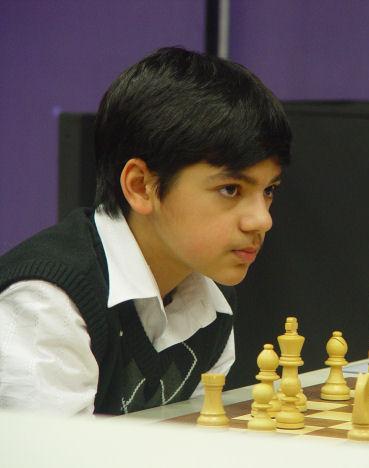 Anish Giri Liviu-Dieter Nsispeanu - Anish Giri 72nd Corus Tournament (Group B), Round 2 Wijk aan Zee, 17 January 2010 Epine Dorsal: Horseman Defense (Janisch Opening) (Petroff Defense) 1.e4 e5 2.Nf3 Nf6 3.Nxe5 d6 4.Nf3 Nxe4 5.c4
5...Nc6 6.Be2
6...Be7 7.0-0 0-0 8.d4 Bf6 9.d5
9...Ne7 10.Nd4!?
10...Re8
11.Na3 Nf5 12.Nac2 Nc5 13.Nb3!?
13...Bd7!?
14.Nxc5 dxc5 15.Bd3 a5 16.Rb1 h6 17.Bd2
17...b6 18.Qf3 Nd6
19.b3 Be5 20.h3 f5 21.Rfe1!?
21...Qf6!?
!""""""""# $t+ +t+l+% $+ Ov+ O % $ O M W O% $O OpCo+ % $ +p+ + +% $+p+b+q+p% $p+nB Pp+% $+r+ R K % /(((((((() WHITE: Liviu-Dieter Nisipeanu Position after 21...Qd8f6 22.Re2!
22...Re7 23.Rbe1 Rae8 24.Qh5!?
24...g6!
25.Qf3
25...Nf7 26.Bf4
26...Kg7
27.Qg3!?
27...Bxf4 28.Qxf4 Ne5
29.Qd2 f4 30.Be4?
!""""""""# $ + +t+ +% $+ O T L % $ O + WoO% $O OpM + % $ +p+vO +% $+p+ + +p% $p+nQrPp+% $+ + R K % /(((((((() WHITE: Liviu-Dieter Nisipeanu Position after 30.Bd3e4 30...Bxh3!! 31.Qc3
31...Bg4 0-1
|
| Printer Friendly | Permalink | | Top |
| Jack Rabbit
|
Sun Jan-24-10 09:12 PM Response to Reply #2 |
| 8. Robson - Swinkels, Group C, Round 2 |
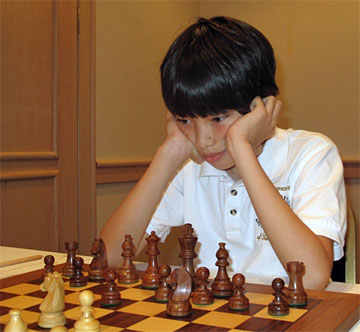 Ray Robson Ray Robson - Robin Swinkels 72nd Corus Tournament (Group c), Round 2 Wijk aan Zee, 17 January 2010 Spanish Grand Royal Game: Clam Opening 1.e4 e5 2.Nf3 Nc6 3.Bb5 a6 4.Ba4 Nf6 5.0-0 Be7 6.Re1 d6
7.c3 Bg4
8.d3
8...Nd7
9.Nbd2
9...Nc5
10.Bc2 Ne6 11.h3 Bh5 12.Nf1 Ng5
13.Bxg5
13...Bxg5 14.Ng3 Bxf3 15.Qxf3 0-0 16.Qg4!?
16...g6
!""""""""# $t+ W Tl+% $+oO +o+o% $o+mO +o+% $+ + O V % $ + +p+q+% $+ Pp+ Np% $pPb+ Pp+% $R + R K % /(((((((() WHITE: Ray Robson Position after 16...g7g6 17.Rf1
17...h5 18.Qd1 Qf6 19.Ne2 Nd8
20.g3 Qf3 21.Kh2 Ne6 22.Ng1
22...Qf6 23.Kg2 Rad8 24.Nf3 Bh6 25.Qe2
25...Rfe8 26.Rad1 Bg7 27.Rfe1 Qe7
28.a3 c5 29.Bb3 b5 30.Nd2!?
30...Bh6!?
31.Nf1 h4 32.Nh2 Kg7 33.Nf3 Bg5 !""""""""# $ + Tt+ +% $+ + WoL % $o+ Om+o+% $+oO O V % $ + +p+ O% $PbPp+nPp% $ O +qPk+% $+ +rR + % /(((((((() WHITE: Ray Robson Position after 33...Bh6g5 34.Rf1
34...Bf6
35.Nh2 Rh8 36.Ng4 Rh7
37.Ne3 Rdh8 38.Qg4 Kf8!?
!""""""""# $ + + L T% $+ + Wo+t% $o+ OnVo+% $+oO O + % $ + +p+qO% $PvPp Pp% $ P + Pk+% $+ +r+r+ % /(((((((() WHITE: Ray Robson Position after 38...Kg7f8 39.Nd5!
39...Qd8 40.f4 hxg3
41.fxe5 Rh4 42.Qf3!
42...Rxh3 43.Qxf6 Rh2+ 44.Kf3 Ng5+ 45.Ke3
45...Qxf6 46.Nxf6 Rxb2 47.exd6 g2!?
48.Rg1!?
48...Rh3+!?
49.Kf4 Nf3
50.Ng8!
50...Ke8
51.Bxf7+ Kd8?
!""""""""# $ + L +n+% $+ + +b+ % $ + P +o+% $+ + + + % $ + +pK +% $P Pp+m+t% $ T + +o+% $+ +r+ R % /(((((((() WHITE: Ray Robson Position after 51...Ke8d8 52.e5!!
52...Nxg1 53.Rxg1 Rf2+
54.Kg4 Rxd3 55.e6 Re3
56.Ne7 Rd2 57.Nc6+ Kc8 58.d7+
58...Kc7
!""""""""# $ + + + +% $+ Lp+b+ % $o+N+p+o+% $+oO + + % $ + + +k+% $P P T + % $ + T +o+% $+ + + R % /(((((((() WHITE: Ray Robson Position after 58...Kd8c7 59.d8Q+!
59...Rxd8 60.Nxd8 Kxd8 61.Rxg2 Rxc3 62.Bxg6 Ke7
63.Bf5 Rxa3 64.Kf4 Ra1 65.Rg7+ Kf6
66.Rf7# 1-0 |
| Printer Friendly | Permalink | | Top |
| Jack Rabbit
|
Sun Jan-24-10 09:20 PM Response to Reply #2 |
| 9. van Wely - Carlsen, Group A, Round 3 |
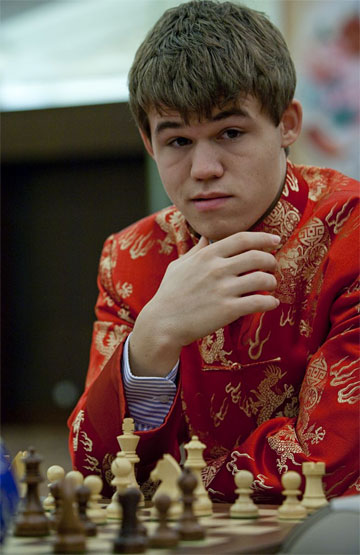 Magnus Carlsen Loek van Wely - Magnus Carlsen 72nd Corus Tournament (Group A), Round 3 Wijk aan Zee, 18 January 2010 Orthodox Queen's Gambit: Hastings Exchange Opening 1.Nf3 Nf6 2.c4 e6 3.Nc3 d5 4.d4 Nbd7 5.cxd5 exd5 6.Bg5 Be7 7.e3 c6 8.Qc2
8...0-0 9.Bd3 Re8 10.h3
10...Ne4 11.Bxe4 dxe4 12.Nxe4 Qa5+ 13.Kf1 Bf8!?
14.Bf4
14...Qf5 15.Nfd2 Nb6
16.Rc1 Nd5 17.g4
17...Qg6 18.Nd6!?
!""""""""# $t+v+tVl+% $Oo+ +oOo% $ +oN +w+% $+ +m+ + % $ + P Bp+% $+ + P +p% $pPqM P +% $+ R +k+r% /(((((((() WHITE: Loek van Wely Position after 18.Ne4d6 18...Rd8!
19.Qxg6 hxg6 20.Nxc8 Nxf4 21.exf4 Rxd4 22.Nb3 Rb4
23.Kg2 Rxc8 24.Rhd1 !""""""""# $ +t+ Vl+% $Oo+ +oO % $ +o+ +o+% $+ + + + % $ T + Pp+% $+n+ + +p% $pP + Pk+% $+ Rr+ + % /(((((((() WHITE: Loek van Wely Position after 24.Rh1d1 24...Rxf4!
25.Rd7
25...Rb4
26.Rc2
26...Re8 27.Rcd2 Be7 28.Rc7 Bf6
29.Rdd7 b6 30.Rxa7 g5 31.Rd2 c5 32.Ra6 c4
33.Nd4 Bxd4 34.Rxd4 Rxb2 35.Rd7?
!""""""""# $ + +t+l+% $+ +r+oO % $rO + + +% $+ + + O % $ +o+ +p+% $+ + + +p% $pT + Pk+% $+ + + + % /(((((((() WHITE: Loek van Wely Position after 35.Rd4d7 35...c3!
36.Raa7 Rf8
37.Rdc7 c2 38.Kg3 Rd8!
39.Rxf7 Rd3+ 40.Kg2
40...c1Q 0-1
|
| Printer Friendly | Permalink | | Top |
| Jack Rabbit
|
Sun Jan-24-10 09:23 PM Response to Reply #2 |
| 10. Short - Nakamura, Group A, Round 3 |
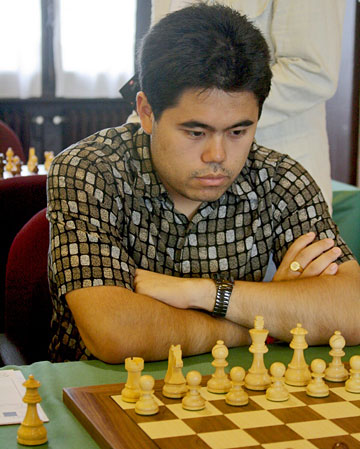 Hikaru Nakamura Nigel Short - Hikaru Nakamura 72nd Corus Tournament (Group A), Round 3 Wijk aan Zee, 18 January 2010 Open Sicilian Game: Boleslavsky Defense 1.e4 c5 2.Nf3 d6 3.d4 cxd4 4.Nxd4 Nf6 5.Nc3 Nc6 6.Be2 e5
7.Nf3 h6 8.0-0 Be6
9.b3 a6!?
10.Re1
10...Rc8
11.Bb2 Be7 12.Bf1 0-0
13.Nd5 Bg4 14.c4 Nxd5
15.exd5 Nb8 16.h3
16...Bh5 17.Be2 Nd7 18.Rc1!?
18...Bg6
19.b4!?
!""""""""# $ +tW Tl+% $+o+mVoO % $o+ O +vO% $+ +pO + % $ Pp+ + +% $+ + +n+p% $pB +bPp+% $+ RqR K % /(((((((() WHITE: Nigel Short Position after 19.b3b4 19...e4!
20.Nd2
20...Qb6!
21.a3 Bh4 22.c5?
22...dxc5 23.Nc4 Qd8
24.Bh5
!""""""""# $ +t+ Tl+% $+ +m+oO % $o+ + +vO% $+o+p+ + % $ +nBo+ V% $P + + +p% $ + +bPp+% $+ R R K % /(((((((() WHITE: Nigel Short Position after 24.Be2h5 24...cxb4!
25.Bxg6
25...fxg6 26.Rxe4
26...Bxf2+ 27.Kh1 b5 28.Ne5
28...Rxc1 29.Bxc1 Nxe5 30.Rxe5 Bg3
31.Re3 Bf4
32.Rd3 Bd6 33.axb4 Qf6 34.Be3 Qf1+ 35.Bg1
35...Rf4 36.g4 Qxd1 37.Rxd1 Rxb4
38.Re1 Rf4 39.Ra1 Ra4 40.Re1
40...b4 41.Re6
!""""""""# $ + + +l+% $+ + + O % $o+ Vr+oO% $+ +p+ + % $tO + +p+% $+ + + +p% $ + + + +% $+ + + Bk% /(((((((() WHITE: Nigel Short Position after 41.Re1e6 41...b3!!
42.Rxd6
42...Rb4 43.Rd8+
43...Kh7 0-1
|
| Printer Friendly | Permalink | | Top |
| Jack Rabbit
|
Sun Jan-24-10 10:17 PM Response to Reply #2 |
| 11. K. Lie - Peng, Group C, Round 2 |
|
If Group C is the Kindergarten, then this game is between the school master and the governess.
 Peng Zhaoqin Kjetil Lie - Peng Zhaoqin 72nd Corus Tournament (Group c), Round 2 Wijk aan Zee, 17 January 2010 Open Sicilian Game: Taimanov Defense 1.e4 c5 2.Nf3 e6 3.d4 cxd4 4.Nxd4 Nc6 5.Nc3 Qc7 6.Be3 a6 7.Bd3
7...Nf6
8.0-0 Nxd4
9.Bxd4 Bc5 10.Bxc5 Qxc5 11.Kh1
11...d6 12.Na4
12...Qc7 13.c4 0-0 14.Rc1 Bd7!?
15.Nc3
15...Bc6 16.f4 Qe7 17.Rc2 Rad8 18.Rd2
18...h6 19.Re1 Rfe8 20.Re3 Qc7 21.Bb1 Qb6
22.Rg3 e5 23.f5 Qc5 24.a3 a5 25.Qe2 Rc8 26.Ba2
26...Kf8 27.Rd1 Red8 28.Rb1 a4 29.Rd1 Rb8
30.Rd2 Ra8 31.h3 Ra6 32.Bb1 Rb6 33.Qd1
33...Rb3?!
!""""""""# $ + T L +% $+o+ +oO % $ +vO + O% $+ W Op+ % $o+p+p+ +% $PtN + Rp% $ P R +p+% $+b+q+ +k% /(((((((() WHITE: Kjetil Lie Position after 33...Rc3b3 34.Nxa4!
34...Bxa4 35.Rxb3 Qxc4
36.Rxd6 Rxd6 37.Qxd6+ Kg8 38.Rg3!?
!""""""""# $ + + +l+% $+o+ +oO % $ + Q M O% $+ + Op+ % $v+w+p+ +% $P + + Rp% $ P + +p+% $+b+ + +k% /(((((((() WHITE: Kjetil Lie Position after 38.Rb3g3 38...Nh5!
39.Rg4 Qc1+
40.Kh2 Bd1
41.Rh4
41...Qxb1 42.Qb8+?!
42...Kh7 43.Qxe5!?
43...Qc2!
44.f6 Nxf6 45.Qf5+?
45...Kg8 46.Rf4
!""""""""# $ + + +l+% $+o+ +oO % $ + + M O% $+ + +q+ % $ + +pR +% $P + + +p% $ Pw+ +pK% $+ +v+ + % /(((((((() WHITE: Kjetil Lie Position after 46.Rh4f4 46...Qc7!
47.Kg1 Bc2
48.b4 b6 49.g4
49...Qc4 50.Qe5 Bxe4 51.Qb8+ Kh7 52.Qxb6 Nd5! 0-1 !""""""""# $ + + + +% $+ + +oOl% $ Q + + O% $+ +m+ + % $ Pw+vRp+% $P + + +p% $ + + + +% $+ + + K % /(((((((() WHITE: Kjetil Lie Final Position after 52...Nf6d5
|
| Printer Friendly | Permalink | | Top |
| Jack Rabbit
|
Sun Jan-24-10 10:21 PM Response to Reply #2 |
| 12. Leko - Shirov, Group A, Round 1 |
|
Edited on Sun Jan-24-10 10:22 PM by Jack Rabbit
Well, for winning his first five games in a row, three of which were each awarded a �500 prize for best game of the round, el se�or Shirov deserves two games this week.
 Alexei Shirov Peter Leko - Alexei Shirov 72nd Corus Tournament (Group A), Round 1 Wijk aan Zee, 16 January 2010 Spanish Grand Royal Game: Neo-Classical Defense Defense 1.e4 e5 2.Nf3 Nc6 3.Bb5 a6 4.Ba4 Nf6 5.0-0 b5 6.Bb3 Bc5 7.a4
7...Rb8 8.Nxe5
8...Nxe5 9.d4 Bxd4 10.Qxd4 d6!?
11.f4
11...Nc6 12.Qc3 Ne7
13.Qd3!?
13...0-0 14.Nc3 b4!
15.e5 Bf5!?
16.Qxa6 Nd7?
!""""""""# $ T W Tl+% $+ OmMoOo% $q+ O + +% $+ + Pv+ % $pO + P +% $+bN + + % $ Pp+ +pP% $R B +rK % /(((((((() WHITE: Peter Leko Position after 16...Nf6d7 17.exd6!
17...bxc3 18.dxe7 Qxe7 19.bxc3
19...Nc5 20.Qc4 Rfd8 21.Ba2 Bxc2 22.f5?
!""""""""# $ T T +l+% $+ O WoOo% $ + + + +% $+ M +p+ % $p+q+ + +% $+ P + + % $b+v+ +pP% $R B +rK % /(((((((() WHITE: Peter Leko Position after 22.f4f5 22...Bd3!
23.f6 gxf6 24.Qg4+
24...Kh8 25.Bh6
25...Rg8 26.Qd4
26...Bxf1 27.Rxf1
27...Rg6 28.Be3 Nxa4
29.Bf2 Nb6 30.Bb1
30...Rg7 31.Re1 Qd6 32.Bf5 Nd5 33.g4
33...Rgg8 34.c4 Nf4?!
!""""""""# $ T + +tL% $+ O +o+o% $ + W O +% $+ + +b+ % $ +pQ Mp+% $+ + + + % $ + + B P% $+ + R K % /(((((((() WHITE: Peter Leko Position after 34...Nd5f4 35.Qxd6!
35...cxd6 36.Bg3 Nh3+ 37.Kg2 Ng5 38.Bxd6 Rb2+ 39.Kg3 Ra8!?
!""""""""# $t+ + + L% $+ + +o+o% $ + B O +% $+ + +bM % $ +p+ +p+% $+ + + K % $ T + + P% $+ + R + % /(((((((() WHITE: Peter Leko Position after 39...Rg8a8 40.Re3!
40...Kg7 41.h4
41...Ne6 42.g5 Raa2 43.gxf6+ Kxf6 44.Bxh7
44...Re2 45.Rf3+ Kg7 46.Bd3 Re1 47.Be7?
!""""""""# $ + + + +% $+ + BoL % $ + +m+ +% $+ + + + % $ +p+ + P% $+ +b+rK % $t+ + + +% $+ + T + % /(((((((() WHITE: Peter Leko Position after 47.Bd6e7 47...Rd2!
48.Bf6+ Kg8 49.Kg4
49...Nc5!
50.Bf5
!""""""""# $ + + +l+% $+ + +o+ % $ + + B +% $+ M +b+ % $ +o+ +kP% $+ + +r+ % $ + T + +% $+ + T + % /(((((((() WHITE: Peter Leko Position after 50.Bd4f5 50...Ne4!
51.Bxe4
51...Rxe4+ 52.Kh5
52...Rxc4
53.Rg3+ Kf8 54.Bg7+ Ke7 55.Re3+ Kd7 56.Bf6
56...Rf2 57.Be5
!""""""""# $ + + + +% $+ +l+o+ % $ + + + +% $+ + B +k% $ +t+ + P% $+ + R + % $ + + T +% $+ + + + % /(((((((() WHITE: Peter Leko Position after 57.Bf6e5 57...Rf5+!
58.Kh6 Rxh4+ 59.Kg7 Rg4+ 60.Kf8 Rf1 61.Rd3+ Ke6 62.Bc7 Rc4 63.Rd6+ Kf5 64.Rd7 Kg4! 0-1
|
| Printer Friendly | Permalink | | Top |
| Jack Rabbit
|
Sun Jan-24-10 07:26 PM Response to Reply #1 |
| 3. Eighth Parsvnath International Open, New Delhi |
 Akshardham Temple, Delhi |
| Printer Friendly | Permalink | | Top |
| Jack Rabbit
|
Sun Jan-24-10 07:29 PM Response to Reply #3 |
| 5. Dzhumaev - Ghaem Maghami, Round 9 |
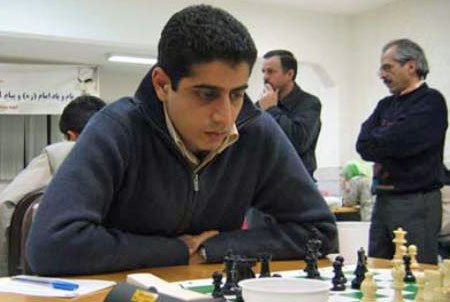 Ehsan Ghaem Maghami Marat Dzhumaev - Ehsan Ghaem Maghami Eighth Parsvnath International Open, Round 9 New Delhi, 20 January 2010 Open Sicilian Game: Najdorf-Boleslavsky Defense (Chandler-Nunn Opening) 1.e4 c5 2.Nf3 d6 3.d4 cxd4 4.Nxd4 Nf6 5.Nc3 a6 6.Be3 e5
7.Nb3 Be7 8.f3 Be6 9.Qd2 h5
10.0-0-0 Nbd7 11.Kb1 Rc8 12.Be2
12...b5 13.Nd5 Bxd5 14.exd5 Nb6 15.Bxb6 Qxb6 16.Qd3!? 16...Nd7
!""""""""# $ +t+l+ T% $+ +mVoO % $oW O + +% $+o+pO +o% $ + + + +% $+n+q+p+ % $pPp+b+pP% $+k+r+ +r% /(((((((() WHITE: Marat Dzhumaev Position after 16...Nf6d7 17.f4!?
17...exf4 18.Nd4 Bf6 19.Qe4+ Be5!
20.g3!?
20...Nf6!
21.Qf5 Qc7 22.gxf4 g6!
23.Qd3 Bxf4 24.Rhf1 Be5
25.Nc6 Nd7 26.Qf3 0-0!?
!""""""""# $ +t+ Tl+% $+ Wm+o+ % $o+nO +o+% $+o+pV +o% $ + + + +% $+ + +q+ % $pPp+b+ P% $+k+r+r+ % /(((((((() WHITE: Marat Dzhumaev Position after 26...0-0 27.Bd3!?
27...Rce8
28.Rg1!?
28...Bg7! 29.Qg2
29...Ne5 30.Be4?
!""""""""# $ + +tTl+% $+ W +oV % $o+nO +o+% $+o+pM +o% $ + +b+ +% $+ + + + % $pPp+ +qP% $+k+r+ R % /(((((((() WHITE: Marat Dzhumaev Position after 30.Bd3e4 30...Nc4!
31.Rd3
31...Qb6 32.Bxg6
32...fxg6
33.Qxg6 Rf7 34.Nd4
34...Ne5 35.Qe4 Ree7 36.Rdg3 Ng4 37.Ne6 Qf2
38.a3 Qf6 39.c3 Qe5 40.Qg6 Qxd5 41.Ng5 Qf5+ 0-1
|
| Printer Friendly | Permalink | | Top |
| Jack Rabbit
|
Sun Jan-24-10 07:30 PM Response to Reply #3 |
| 6. Tania - Debayan, Round 4 |
 Tania Sachdev Tania Sachdev - Majumdar Debayan Eighth Parsvnath International Open, Round 4 New Delhi, 16 January 2010 Queen's Gambit: Albin Counter Gambit 1.d4 d5 2.c4 e5
3.dxe5 d4 4.Nf3
4...Nc6 5.a3
5...a5
6.e3 Bc5 7.exd4 Nxd4
8.Be3!?
!""""""""# $t+vWl+mT% $+oO +oOo% $ + + + +% $O V P + % $ +pM + +% $P + Bn+ % $ P + PpP% $Rn+qKb+r% /(((((((() WHITE: Majumdar Debayan Position after 8.Bc1e3 8...Bg4
9.Be2 Nxf3+
10.gxf3 Qxd1+
11.Bxd1 Bxe3 12.fxe3 Be6 13.Be2
13...0-0-0 14.Nc3 Ne7 15.Ne4
15...Bf5 16.Nc3 h5 17.f4 g6
18.b4
18...Bd3 19.h4 Kb8 20.Bxd3?
20...Rxd3!
21.Ke2?
21...Rhd8?
22.Rad1!
22...Rxd1 23.Rxd1 Rxd1 24.Kxd1 axb4 25.axb4 Kc8?
!""""""""# $ +l+ + +% $+oO Mo+ % $ + + +o+% $+ + P +o% $ Pp+ P P% $+ N P + % $ + + + +% $+ +k+ + % /(((((((() WHITE: Majumdar Debayan Position after 25...Kb8c8 26.Kd2!
26...Kd7 27.Kd3 b6 28.e4 c5
29.b5 Ke6 30.Nd1 Ng8 31.Ne3 1-0
|
| Printer Friendly | Permalink | | Top |
| Jack Rabbit
|
Mon Jan-25-10 05:09 PM Response to Original message |
| 13. Chess on The Rock: Eighth Gibraltar Chess Festival Begins Tomorrow (Tuesday) |
 The eighth annual Gibraltar International Chess Festival, sponsored by Gibtelecom, the local telecommunications comapany and featuring a strong open masters' tournament, begins tomorrow, Tuesday, January 26 at the Caleta Hotel on The Rock. The top seeded players in the event are French granmaster Etienne Bacrot, Sergei Movsesian of Slovakia and Spain's Paco Vallejo. As usual, the rich prizes presented for achievements by women in the event have attacted such ladies as Swedish GM Pia Cramling, long a regular at Gibraltar, GMs Koneru Humpy of India and Nana Dzagnidze of Georgia (who won the women's prize last year), reigning world women's champion Alexandra Kosteniuk of Russia and former world women's champion Antoeneta Stefanova of Bulgaria. The games begin at 3 pm local time (6 am PST) and will be covered through Monroi on the Official Tournament Website.  Some of Gibraltar's local inhabitants know instinctively what to do with weapons of war |
| Printer Friendly | Permalink | | Top |
| DU
AdBot (1000+ posts) |
Mon Apr 29th 2024, 08:52 PM Response to Original message |
| Advertisements [?] |
| Top |
| Home » Discuss » Topic Forums » Sports |
|
Powered by DCForum+ Version 1.1 Copyright 1997-2002 DCScripts.com
Software has been extensively modified by the DU administrators
Important Notices: By participating on this discussion board, visitors agree to abide by the rules outlined on our Rules page. Messages posted on the Democratic Underground Discussion Forums are the opinions of the individuals who post them, and do not necessarily represent the opinions of Democratic Underground, LLC.
Home | Discussion Forums | Journals | Store | Donate
About DU | Contact Us | Privacy Policy
Got a message for Democratic Underground? Click here to send us a message.
© 2001 - 2011 Democratic Underground, LLC